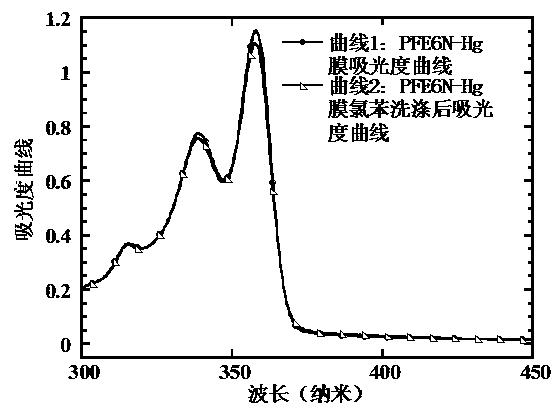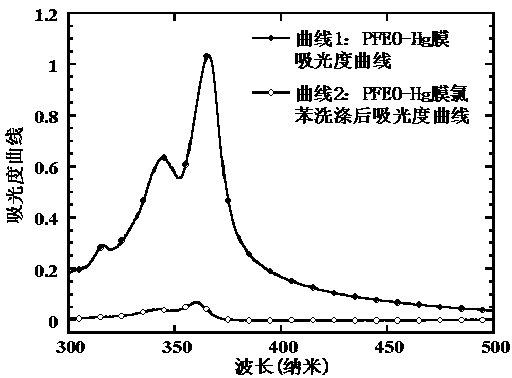Conjugated metal polymer photoelectric material with functionalized polarity side-chain radicals and application thereof
A metal polymer, polar side chain technology, used in photovoltaic power generation, circuits, electrical components, etc., can solve the problems of few reports, conjugated metal polymers have not attracted attention, etc., to achieve reduced thickness dependence, good electronic Transmission/extraction performance, multi-selective effects
- Summary
- Abstract
- Description
- Claims
- Application Information
AI Technical Summary
Problems solved by technology
Method used
Image
Examples
Embodiment 1
[0046] Conjugated metal polymer optoelectronic materials with functionalized polar side chain groups poly[2,7-diethynyl-9,9'-bis(6-N,N-diethylamino-hexyl)fluorene- Mercury] (abbreviated as PFE6N-Hg) preparation
[0047] The synthetic route is as follows:
[0048]
[0049] (1) 2,7-diethynyl-9,9'-bis(6-bromo-hexyl)fluorene (monomer 4) was prepared according to the method disclosed in the literature [J.Phys.Chem.B2008,112,9295] .
[0050] (2) Synthesis of 2,7-diethynyl-9,9’-bis(6-N,N-diethylamino-hexyl)fluorene (monomer FE6N)
[0051] Add the raw material 2,7-diethynyl-9,9'-bis(6-bromo-hexyl)fluorene (4.74g, 9.0mmol) into the reaction flask, add 300mL N,N-dimethylformamide (DMF ) to dissolve the raw material, then add diethylamine (15mL), heat and reflux for 12h under argon protection, pour the reaction solution into ice water after cooling, extract and concentrate with dichloromethane, and pass the concentrate through the column to obtain Product 4.38g, yield 85%.
[005...
Embodiment 2
[0059] Conjugated metallopolymer optoelectronic material poly[2,7-diethynyl-9,9'-bis(3-N,N-diethylamino-propyl)fluorene with functionalized polar side chain groups - Mercury] (abbreviated as PFE3N-Hg) preparation
[0060] The synthetic route is as follows:
[0061]
[0062] (1) 2,7-dibromo-9,9'-bis(3-bromo-propyl)fluorene (monomer 5)
[0063] Add the raw material 2,7-dibromofluorene (13.0g, 40mmol) into the reaction flask, add 150mL of 1,3-dibromopropane, stir, add 20mL of 50% sodium hydroxide aqueous solution, 0.5g of tetrabutylammonium bromide, Under the protection of argon, the reaction was carried out at 50-60°C for 12 hours. After cooling, the reaction liquid was poured into ice water, extracted with dichloromethane, concentrated, and the concentrate was passed through a column to obtain 18.1 g of the product with a yield of 80%.
[0064] The NMR data of the product are as follows:
[0065] 1 H NMR (300MHz, CDCl 3 ,δ,ppm)7.55-7.49(m,6H),3.15-3.11(t,4H,J=6.54Hz),2....
Embodiment 5
[0093] The polymer PFE6N-Hg synthesized in Example 1 is taken as an example to illustrate that this polymer has the property of resisting solvent (chlorobenzene) elution, and can use orthogonal solvents to prepare multilayer organic / polymer solar cell devices.
[0094]Dissolve PFE6N-Hg in 1,4-dioxane, filter through a 0.45μm organic filter, and spin-coat on a common glass slide to form a film with a thickness of about 20nm. The absorbance of PFE6N-Hg after film formation was measured with a UV tester (HP8453spectrophotometer) produced by Hewlett-Packard Company, corresponding to figure 1 Curve 1 in . PFE6N-Hg is eluted with chlorobenzene afterwards PFE6N-Hg film, the absorbance of the PFE6N-Hg film after UV test elution, corresponds to figure 1 Curve 2 in . By observing that the absorbance of the PFE6N-Hg film does not decrease substantially after elution with chlorobenzene, it has excellent anti-solvent elution performance.
[0095] figure 1 The ultraviolet-visible light ...
PUM
 Login to View More
Login to View More Abstract
Description
Claims
Application Information
 Login to View More
Login to View More - R&D
- Intellectual Property
- Life Sciences
- Materials
- Tech Scout
- Unparalleled Data Quality
- Higher Quality Content
- 60% Fewer Hallucinations
Browse by: Latest US Patents, China's latest patents, Technical Efficacy Thesaurus, Application Domain, Technology Topic, Popular Technical Reports.
© 2025 PatSnap. All rights reserved.Legal|Privacy policy|Modern Slavery Act Transparency Statement|Sitemap|About US| Contact US: help@patsnap.com



